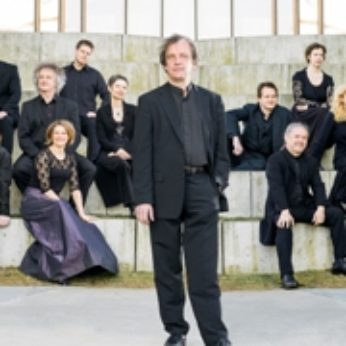Composer: Antonio Vivaldi (b. 1678 - d. 1741)
Performance date: 03/07/2014
Venue: St. Brendan’s Church
Composition Year: 1712
Duration: 00:16:16
Recording Engineer: Anton Timoney, RTÉ lyric fm
Instrumentation Category:Small Mixed Ensemble
Instrumentation Other: 3vn, va, vc, db, lu, hpd
Artists:
Concerto Copenhagen (Peter Spissky, Fredrik From, Antina Hugosson [violins], Torbjörn Köhl [viola], Kate Hearne [cello], Mattias Frostenson [bass], Fredrik Bock [archlute, guitar], Lars-Ulrik Mortensen [harpsichord, director]) -
[baroque ensemble]

Some
four years after this concerto was written, the Electoral Prince of Saxony
enjoyed a prolonged stay in Venice. He brought with him from Dresden an elite
group of musicians that included the violinist Johann Georg Pisendel, organist
Christian Petzoid, oboist Johann Richter and violone player (and composer) Jan
Zelenka. The extended stay of the Prince and his musicians laid the foundations
for the diffusion of Italian music in Germany over the following decades and
made Dresden the centre of the Vivaldian cult in German-speaking countries.
Pisendel
was a brilliant violinist and he quickly struck up a friendship with Vivaldi,
who gave him autograph scores of a number of concertos and sonatas that he
dedicated to him. Also Pisendel copied out a large number of Vivaldi’s scores
in his own hand, sometimes revising them to accord to the tastes and
performance practice of the Dresden orchestra, well known for its prominent use
of wind instruments. This morning’s concerto exists in two versions, one in
Turin and one in Dresden that had been copied by Pisendel, but with many of his
typical changes. Both versions are damaged and to complicate things there is a
later version of RV 212 from around 1718 that
may have been revised for Pisendel. In Baroque and early repertoire it
is sometimes almost impossible to get back to the original score and parts
unless Providence intervenes as with the extraordinary discovery of what is now
known as the Turin Collection.
The
concerto itself is a spectacular work, festive in character and demanding from
the soloist strength, agility and precise intonation in the double stops and in
the top register. There are also some hair-raising cadenzas.
Copyright © 2025 West Cork Music. All rights reserved.
Designed and developed by Matrix Internet